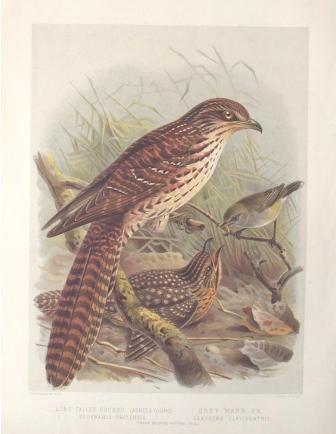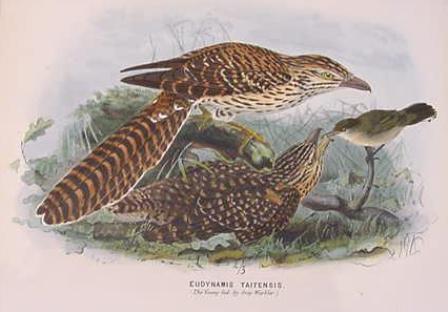
“This cuckoo is sometimes called the screamer, from its loud thrill note. It resembles the shining cuckoo only in its parasitical habit, and in the mystery of its migration. It arrives later — towards the end of October or the beginning of November and leaves in January of February,” says Andersen.
“Its movements are not traced so easily as those of the ’wharauroa as it seems to move about chiefly at night. Its winter quarters are not certainly known; birds having been obtained in the Solomon Islands but rarely in New Caledonia. They have also been reported in Fiji, the Friendly Islands, the Marquesas, Samoa and other Pacific Islands but the land from which they first set out on their southern migration is not known. As with the shining cuckoo, the old birds leave earlier than the young on their departure for New Zealand.
“The white–head appears to be the bird most often chosen as host for the egg of the long–tailed cuckoo, though eggs supposed to belong to it have been recorded in the nests of the tom-tit, warbler, and blight-bird; and besides these birds, the pigeon and tui have been seen feeding the young cuckoo, so they too may have been foster parents; — though as before noted , birds may be foster feeders that are not foster parents.
“It once seemed doubtful if an egg was ever placed in the nest of Riroriro, as the young of the shining cuckoo fills it completely when fledged, and the long–tailed cuckoo is a much larger bird, but the insertion of the egg in the nest has actually been observed by Mr. Overton in Otago. The egg was first laid on the ground, and then carried by the bird in its beak and placed in the nest. The same observer saw a cuckoo attempt, but fail to place an egg in the nest of a Tui.
“The call of the long–tailed cuckoo is a loud, shrill whistle, slurred upwards, like the call of the green linnet, but very much louder and more intense. It is louder and more piercing than any other bird–voice in the bush, with a rapid crescendo on the sustained note, and a gradual diminuendo as it slurs deliberately upwards. In quality the note is a whistle, and its burrs shrilly as though the bird had a pea in its larynx. A cry may vary in interval and pitch, and may be followed by other notes, the whole of which took two seconds, the notes vocalized wheet wheet being very incisive. Whilst two birds were circling in the air, wheet wheet was repeated quickly, four wheets to the second, many times at intervals.
“Taylor of the long–tailed cuckoo; “Its appearance is a token of the planting of the kumara, and its departure, that is the time to dig them up. Some have an idea that this bird hibernates under the water. The Taupo natives think that it creeps into holes, where it turns into a lizard, and loses its feathers; on the approach of summer, it crawls out of its hole, it feathers then begin to grow, the tail drops off, and it again becomes a bird. In its lizard form, it is called he ngaha, but in the Wanganui, he piri rewa, or tree lizard. The natives say, that always before the wind is about to blow from the south, the kohoperoa ceases to sing, and does not commence till the west wind blows, or till a breeze springs up from the north. When a child is deserted by its parents, it is said to be Te parahaka ot te koekoea, the reject of the koekoea. The proverb quoted by Taylor is given in another form by Grey, He potiki na te koekoea, the offspring of the long–tailed cuckoo — as applied to an illegitimate child.
“It is curious that the myth of bird–hibernation should spring up in New Zealand soil as in that of the Old World; or perhaps it would be curious if it were otherwise; it is one of those touches of nature which makes the whole world kin. The myth would appear, however, to have originated among the inland dwellers, if the dwellers in the northern sea–washed peninsula did actually ever see the arrival of birds.
“The gathering of the long–tailed cuckoo as if for migration has perhaps been seen. I have been told by an old bush–loving surveyor that on one occasion, when camped on a sharp ridge between Coromandel and Thames, he heard a great twittering; and, attracted by the sound, he investigated the cause. He found large numbers of the cuckoo gathered together; and suspecting from the time of year, that a gathering might be for migration, he watched during the night; but they remained that night, and the next day, when still more arrived. He said they were in hundreds. He watched next night, too, but must have dozed off, for in the morning all were gone”.
Link to the Map of the winter range of the long-tailed cuckoo: Winter range Map

Other common names: —
Kohoperoa, bronze cuckoo, long-tailed koel, screamer.
Description: —
Endemic bird
40 cm., 125 g., upperparts rich brown barred with black, underparts buff streaked with brown and black; the sexes are alike.
Where to find: —
Widespread but not common.
More Information: —
Poetry: —
Ko te uri au i te whenakonako
I te koekoea.
E riro nei ma te tataihore e whangai.
I am the offspring of the bronze cuckoo,
Of the long-tailed cuckoo,
Left here for the white-head to feed.
Sumer is icumen in,
Lhude sing cuccu!
Groweth sed, and bloweth med,
And springth the wude nu–
Sing cuccu!
Awe bleteth after lomb,
Lhouth after calve cu;
Bulluc sterteth, bucke verteth,
Murie sing cuccu!
Cuccu, cuccu, well singes thu, cuccu:
Ne swike thu naver nu;
Sing cuccu, nu, sing cuccu,
Sing cuccu, sing cuccu, nu!
— Anonymous. Middle English, 13th cent.
Illustration description: —
Buller, Walter Lawry, Birds of New Zealand, 1888.
Buller, Walter Lawry, Birds of New Zealand, 1873.
Reference(s): —
Andersen, Johannes C., New Zealand Song Birds, 1926.
Page date & version: —
Monday, 26 May 2014; ver2009v1

